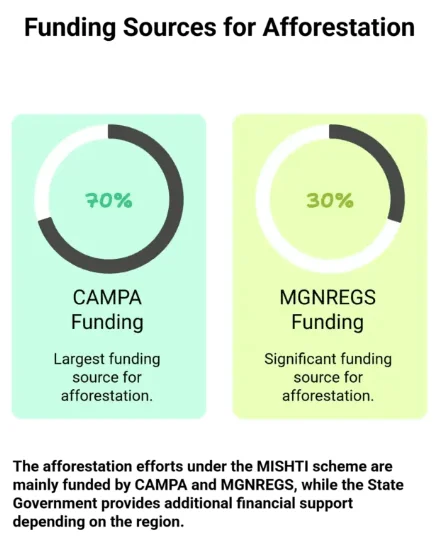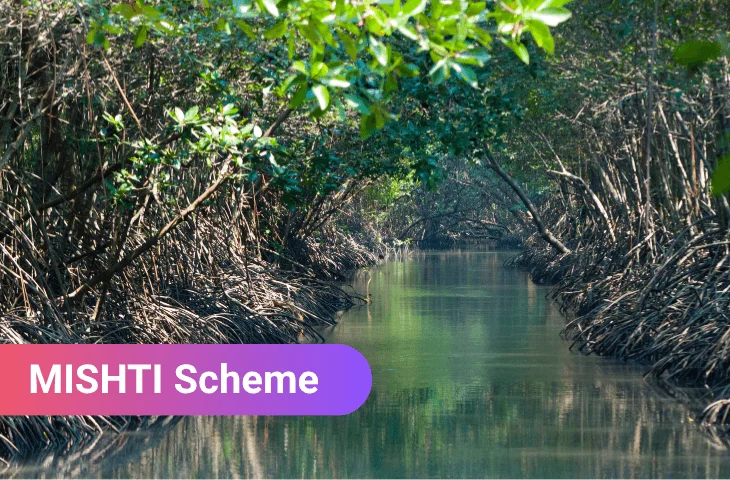The MISHTI Scheme stands for Mangrove Initiative for Shoreline Habitats & Tangible Incomes. It is a flagship program launched by the Ministry of Environment, Forest and Climate Change (MoEFCC) on 5th June 2023, coinciding with World Environment Day. The initiative aims to restore and conserve mangrove ecosystems across India’s coastline and salt pan lands, addressing both environmental and socio-economic objectives.
The scheme emerged after India joined the Mangrove Alliance for Climate, launched at COP27 in Egypt (2022), reflecting the country’s commitment to climate change mitigation and biodiversity conservation.
MISHTI is envisioned as a five-year program, spanning 2023–2028, targeting approximately 540 square kilometers of mangrove habitats across 11 coastal states and 2 Union Territories.
Why was the MISHTI Scheme Launched?
The MISHTI Scheme was introduced with multiple objectives:
| Focus Area | Key Actions | Impact |
| Mangrove Restoration | Replanting degraded mangroves and abandoned salt pans | Restores ecosystems, supports marine life, protects biodiversity |
| Coastal Protection & Resilience | Mangroves act as natural barriers against storms and erosion | Protects villages, farms, infrastructure; strengthens coastal resilience |
| Livelihood Generation | Eco-tourism, fishing, and sustainable harvesting of products | Boosts local incomes and socio-economic well-being |
| Climate Change Mitigation | Mangroves absorb and store large amounts of carbon | Reduces greenhouse gases; supports India’s climate goals |
How is the MISHTI Scheme Implemented?
MISHTI is implemented using a multi-level governance structure, ensuring accountability and efficiency:
- National Level: The Green India Mission Directorate serves as the national implementing agency.
- State Level: State Forest Departments and dedicated MISHTI Cells oversee state-specific operations.
- District Level: District MISHTI Cells, led by District Collectors, manage local implementation.
Role of Community Participation
Community involvement is a key pillar of MISHTI. The scheme ensures that local residents, NGOs, and Self-Help Groups (SHGs) actively participate in:
- Plantation and restoration activities
- Awareness campaigns to educate people about mangroves
- Eco-tourism initiatives for income generation
This participatory approach ensures sustainability and ownership of conservation efforts. MISHTI leverages convergence of financial resources from various sources:

Areas Covered Under MISHTI Scheme
The scheme focuses on coastal and wetland ecosystems in India. Some key locations include:
- Sundarbans Delta (West Bengal): The world’s largest mangrove forest, home to the Royal Bengal Tiger.
- Hooghly Estuary (West Bengal): A critical zone for fisheries and biodiversity.
- Gulf of Kutch (Gujarat): Houses Marine National Park & Wildlife Sanctuary, covering 799 sq. km of mangrove forest.
- Gulf of Khambhat (Gujarat): Supports coastal protection and marine life.
- Other Coastal States: Odisha, Maharashtra, Tamil Nadu, Kerala, Karnataka, Goa, Andhra Pradesh, Lakshadweep, and Andaman & Nicobar Islands.
The targeted restoration area is around 540 sq. km, with Gujarat alone achieving 190 sq. km in just two years.
Also Check: List of Government Schemes of India
What are the Key Activities Under MISHTI?
The key activities under the MISHTI scheme are as follows:
| Focus Area | Key Activities |
| Plantation and Restoration | – Reforestation of degraded mangrove areas – Afforestation of abandoned salt pans and aquaculture ponds – Rehabilitation of areas infested with invasive species |
| Awareness and Education | – Community campaigns highlighting the importance of mangroves – Workshops for local stakeholders on sustainable practices |
| Livelihood Promotion | – Eco-tourism initiatives – Sustainable harvesting of honey, timber, and medicinal plants – Support for fisheries and aquaculture |
| Monitoring and Evaluation | – Regular assessment of mangrove growth – Use of technology for tracking carbon sequestration – Periodic reporting to national and state authorities |
Why are Mangroves Important for Coastal India?
Mangroves are vital coastal ecosystems that provide multiple ecological, social, and economic benefits. They protect coastlines, support biodiversity, and help communities adapt to climate change while providing sustainable livelihood opportunities.
- Coastal Protection: Mangroves act as natural buffers, preventing erosion, flooding, and protecting agricultural lands and human settlements from storms and cyclones.
- Biodiversity Support: They provide critical habitats and breeding grounds for fish, crabs, mollusks, and migratory birds, enhancing coastal biodiversity.
- Livelihoods: Mangroves sustain local communities through fishing, honey collection, timber, and medicinal plants.
- Climate Mitigation: These forests absorb and store carbon efficiently, helping reduce greenhouse gas emissions and combat climate change.
- Salinity Control: During high tides and storms, mangroves regulate soil and water salinity, protecting agriculture and freshwater resources.
Check Out: Complete List of Important Schemes for NABARD Grade A Exam
How has Gujarat Led MISHTI Implementation?
Gujarat has emerged as a national leader in mangrove afforestation:
- 19,020 hectares planted in two years
- Contribution to national target of 540 sq. km: nearly 35% achieved in just two years
- Active use of public-private partnerships to fund and manage restoration projects
- Key areas: Gulf of Kutch, Gulf of Khambhat, Bhavnagar, Dumas-Ubhrat, and Saurashtra regions
This achievement aligns with Gujarat’s vision of Viksit Gujarat to Viksit Bharat, reflecting strong policy implementation and community engagement.
Get ready to crack government job exams with leading educators
Which Laws Support Mangrove Conservation in India?
Several laws and regulations provide a framework for protecting mangroves:
| Law/Regulation | Purpose | Relevance to Mangroves |
| Environment Protection Act, 1986 | Protect the environment | Grants authority to protect mangroves from pollution and degradation |
| Forest (Conservation) Act, 1980 | Regulates forest land diversion | Mangroves considered forest land requiring clearance for non-forest use |
| Coastal Regulation Zone (CRZ) Notification, 2011 | Regulates coastal activities | Protects mangroves in sensitive zones from industrial development |
| National Wildlife Protection Act, 1972 | Protects wildlife | Mangrove areas often designated as protected areas |
| Biological Diversity Act, 2002 | Biodiversity conservation | Promotes mangrove conservation and management plans |
| Wetlands (Conservation & Management) Rules, 2017 | Wetland protection | Protects mangrove wetlands from reclamation and degradation |
| Forest Rights Act, 2006 | Rights of forest dwellers | Supports community involvement in mangrove conservation |
What are the Challenges Faced by MISHTI?
Despite progress, the MISHTI Scheme faces several challenges:
- Sea Level Rise: Mangroves are vulnerable to rising sea levels, which can submerge coastal habitats.
- Soil Salinity and Sedimentation: High salinity or disrupted sediment patterns hinder mangrove growth.
- Inadequate Funding: Restoration projects require long-term investment, and current funds may be insufficient.
- Policy Enforcement: Strict adherence to CRZ regulations and other protective laws is essential.
- Climate Change Threats: Increasing cyclones, temperature changes, and coastal erosion can affect restoration success.
Key Takeaways
| Aspect | Key Points |
| Launch | 5th June 2023, by MoEFCC |
| Duration | 2023–2028 (5 years) |
| Coverage | 11 states + 2 Union Territories; 540 sq. km target |
| Funding | 70% CAMPA, 30% MGNREGS, state contribution |
| Implementation | National, State, and District MISHTI Cells |
| Focus Areas | Sundarbans, Gulf of Kutch, Gulf of Khambhat, other coastal wetlands |
| Community Engagement | SHGs, NGOs, local residents actively involved |
| Gujarat Achievement | 19,020 hectares planted in 2 years |
| Objectives | Coastal protection, mangrove restoration, livelihood generation, climate mitigation |
| Challenges | Sea level rise, salinity, funding, policy enforcement |
Questions Based on MISHTI Scheme
- When was the MISHTI Scheme launched?
A) 2022
B) 2023
C) 2021
D) 2024
E) 2020 - What does MISHTI stand for?
A) Mangrove Initiative for Sustainable Habitats & Trade Incentives
B) Mangrove Initiative for Shoreline Habitats & Tangible Incomes
C) Mangrove Improvement Scheme for Habitat and Tourism Initiatives
D) Mangrove India Sustainability & Habitat Initiative
E) Mangrove Initiative for Social and Habitat Income - How many states and Union Territories are covered under MISHTI?
A) 10 states, 2 UTs
B) 11 states, 2 UTs
C) 12 states, 3 UTs
D) 9 states, 3 UTs
E) 11 states, 1 UT - Which Indian state leads mangrove afforestation under MISHTI?
A) West Bengal
B) Odisha
C) Gujarat
D) Tamil Nadu
E) Kerala - What is the target mangrove restoration area under MISHTI?
A) 100 sq. km
B) 300 sq. km
C) 540 sq. km
D) 700 sq. km
E) 400 sq. km - Which funding sources are converged for MISHTI?
A) CAMPA and MGNREGS
B) CAMPA and NABARD
C) MGNREGS and CSR funds
D) State budgets only
E) None of the above - Which international initiative is MISHTI linked to?
A) Mangrove Alliance for Climate
B) Blue Carbon Initiative
C) Global Mangrove Watch
D) UN Ocean Alliance
E) Coastal Resilience Alliance - What is a key ecological benefit of mangroves?
A) Timber production only
B) Coastal protection and carbon sequestration
C) Tourism development
D) Mining resources
E) Industrial growth - Which Gulf in Gujarat has a significant mangrove cover?
A) Gulf of Khambhat
B) Gulf of Kutch
C) Gulf of Mannar
D) Gulf of Cambay
E) Gulf of Bengal - Which government agency implements MISHTI nationally?
A) National Biodiversity Authority
B) Indian Council of Forestry Research & Education
C) Green India Mission Directorate
D) UNDP
E) Mangroves for the Future
Also Read:
Answer Key
| Question No. | Correct Answer | Question No. | Correct Answer |
| 1 | B | 6 | A |
| 2 | B | 7 | A |
| 3 | B | 8 | B |
| 4 | C | 9 | B |
| 5 | C | 10 | C |
- MISHTI Scheme, India’s Initiative to Restore Mangrove Ecosystems
- National Green Hydrogen Mission Features, Objectives, and Benefits
- Paramparagat Krishi Vikas Yojana, Transforming India’s Organic Farming
- Mission on Integrated Development of Horticulture NHM and HMNEH
- Swachh Bharat Mission, India’s Journey Towards Cleanliness and Hygiene
- SAGY, A Step Towards Holistic Development of Indian Villages

Hi, I’m Aditi. I work as a Content Writer at Oliveboard, where I have been simplifying exam-related content for the past 4 years. I create clear and easy-to-understand guides for JAIIB, CAIIB, and UGC exams. My work includes breaking down notifications, admit cards, and exam updates, as well as preparing study plans and subject-wise strategies.
My goal is to support working professionals in managing their exam preparation alongside a full-time job and to help them achieve career growth in the banking sector.
